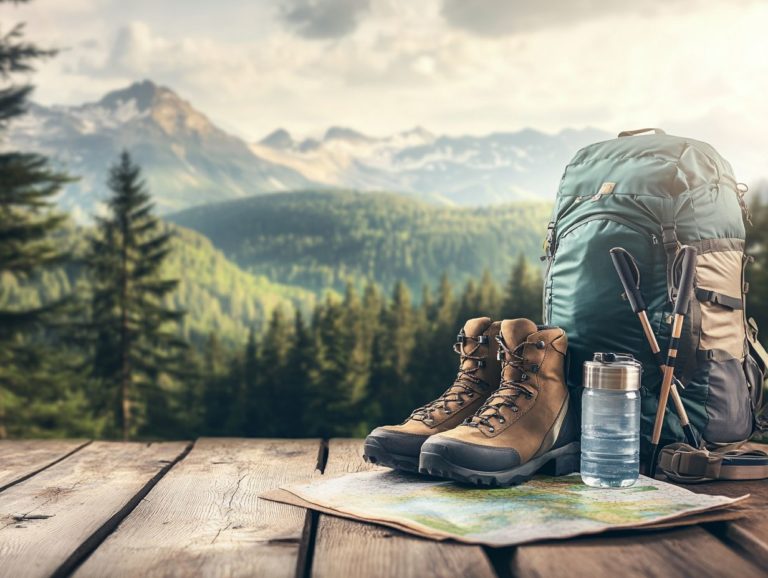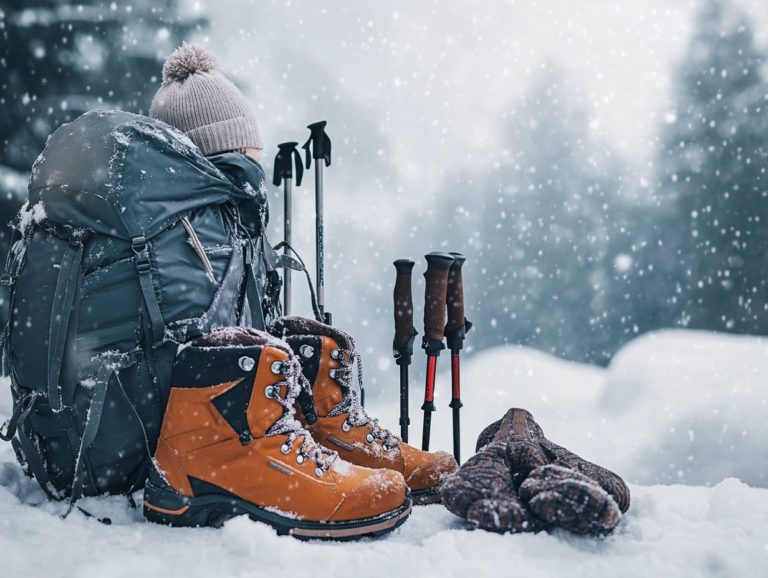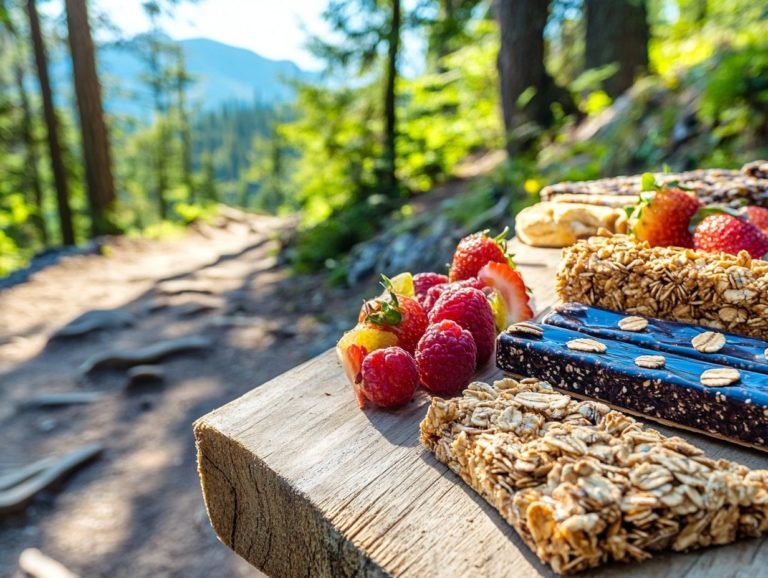How to Prepare for a Long Hike
Planning a long hike is a thrilling first step on your adventure. To ensure your journey unfolds successfully, you’ll need to address several key elements, from selecting the ideal trail to assembling your essential gear.
Understanding how to craft a solid timeline, prepare both physically and mentally, and maintain proper nutrition and hydration will pave the way for an unforgettable experience. Being prepared for emergencies is crucial.
Dive into this guide to equip yourself for the journey that awaits!
Contents
- Key Takeaways:
- Planning for a Long Hike
- Essential Gear for a Long Hike
- Physical Preparation for a Long Hike
- Mental Preparation for a Long Hike
- Nutrition and Hydration for a Long Hike
- Emergency Preparedness on a Long Hike
- Frequently Asked Questions
- What are some essential items to bring on a long hike?
- How physically fit do I need to be to prepare for a long hike?
- What is the best way to train for a long hike?
- How should I plan my meals for a long hike?
- What are some safety tips to keep in mind when preparing for a long hike?
- How far in advance should I start preparing for a long hike?
Key Takeaways:

- Choose the right trail and create a timeline to plan for a successful long hike.
- Pack essential gear for safety and comfort, including proper footwear, navigation tools, and first aid supplies.
- Train physically and mentally to build endurance and stay motivated on the long hike.
Planning for a Long Hike
Planning for a long hike involves several important factors. Consider the difficulty of the hiking route, your physical fitness level, and the specific outdoor experiences you wish to pursue, especially on legendary trails like the Appalachian Trail.
By putting a solid plan in place, you can elevate your hiking enjoyment and adequately prepare for the journey ahead.
Choosing the Right Trail and Route
Choosing the right trail and route is vital for your hiking success. Popular paths like the Appalachian Trail offer a variety of routes catering to different skill levels.
As you select your hiking trail, evaluate several key factors to ensure you re well-prepared for the adventure ahead.
First and foremost, the difficulty level is crucial. It can significantly affect your enjoyment and safety. If you’re a beginner, you might prefer flatter, well-marked paths. Seasoned hikers might crave the thrill of challenging ascents.
Consider the terrain you’ll encounter as well. Whether it’s rocky inclines or soft forest trails, different terrains demand specific hiking techniques, such as proper foot placement and maintaining balance.
Don t overlook weather conditions. Checking forecasts and understanding how temperature fluctuations and precipitation can impact trail conditions will help you minimize risks.
Ultimately, a thoughtful assessment of these elements will lead you to a fulfilling hiking experience.
Creating a Timeline and Itinerary
Creating a timeline and itinerary for your hike ensures you re well-prepared and respectful of your physical limits. This offers a structured approach to your outdoor adventure.
By thoughtfully mapping out each day’s journey, you can set realistic daily mileage goals that align with your fitness level and the terrain ahead. This strategy transforms the overall distance into manageable segments.
Incorporating essential rest points for recovery and hydration is also important. Estimating completion times for each segment is crucial as you need to consider factors like elevation changes and weather conditions.
With meticulous planning, you elevate your hike from a spontaneous venture into a safer, more enjoyable experience. This allows you to fully immerse yourself in the beauty of nature while minimizing risks.
Essential Gear for a Long Hike
The essential gear for a long hike is crucial for ensuring both your safety and comfort during your outdoor adventure. You ll want to invest in must-have items like high-quality hiking shoes, appropriate clothing, and well-tested hiking equipment.
These choices can significantly impact your overall enjoyment and performance on the trail.
Start planning your hike today by knowing what to pack for a day hike and embrace the adventure ahead!
Must-Have Items for Safety and Comfort
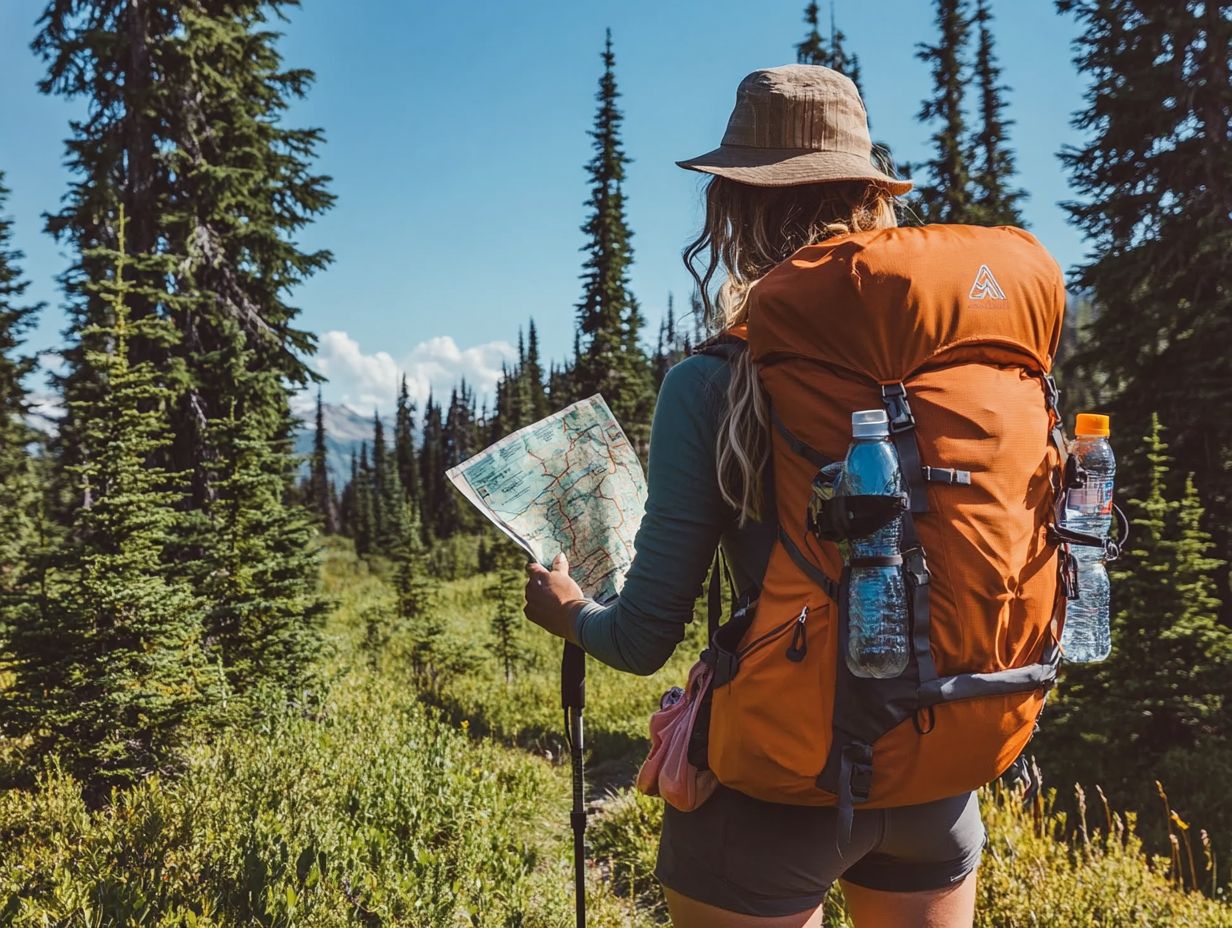
When you’re gearing up for a long hike, there are a few must-have items that are essential for your safety and comfort. Adequate hydration options, suitable hiking gear, and a well-stocked first aid kit are crucial for addressing common hiking injuries and ensuring your well-being on the trail.
Hydration packs are your best friend! They hold water and let you sip easily without breaking your stride. For more tips on maintaining fluid levels, check out how to stay hydrated while hiking. Don’t underestimate the importance of sturdy hiking boots; they provide the support and grip you need on uneven terrain.
A comprehensive first aid kit filled with band-aids, antiseptic wipes, and pain relievers can truly be a lifesaver when blisters or scrapes occur. Don t leave home without a multi-tool it s a lifesaver for unexpected repairs! Don t forget lightweight thermal blankets, which are a cozy safeguard against sudden drops in temperature.
Let s not overlook sunscreen and insect repellent; these are your allies in warding off harmful UV rays and pesky bugs. These items create a safer and more enjoyable hiking experience, allowing you to focus on the beauty of the trail ahead.
Physical Preparation for a Long Hike
Physical preparation for a long hike is essential and involves several key components, such as building stamina, strength training, and a thoughtfully designed fitness routine.
This approach not only prioritizes injury prevention but also elevates your overall physical activity level. This ensures that your hiking experience is both enjoyable and fulfilling.
Training and Conditioning Tips
Training and conditioning tips for hikers revolve around a strategic blend of stamina building, effective workout cycles, and engaging in diverse physical activities.
To prepare thoroughly, incorporate exercises like trail running, which mirrors the uneven terrain you ll often face on hikes. You can also go biking to elevate your cardiovascular health while targeting essential leg muscles.
Swimming serves as an excellent low-impact option to boost your lung capacity and overall endurance. These activities not only enhance your aerobic fitness which is about how well your body uses oxygen during exercise but also promote recovery, building a balanced and resilient body ready to conquer challenging landscapes.
By crafting a well-rounded routine, you ll ensure that you re primed and ready for your next adventure.
Mental Preparation for a Long Hike
Mental preparation for a long hike is just as vital as physical readiness. Cultivating your mental strength and resilience enables you to maintain motivation during challenging moments, ultimately elevating your overall enjoyment and success on the trail.
Staying Motivated and Focused
Staying motivated and focused during a lengthy hike is crucial for overcoming mental fatigue and ensuring you fully enjoy your outdoor adventure.
To make this easier, set small, manageable goals for yourself, like reaching a particular viewpoint or designating a rest stop along the trail. This incremental approach breaks down the journey into more approachable segments and provides rewarding milestones that can uplift your spirits.
Embrace mindfulness by tuning into the soothing sounds of rustling leaves, the cheerful chirping of birds, or the invigorating scent of pine. This practice deepens your connection to nature and cultivates a sense of presence.
Let the breathtaking views and vibrant flora inspire you! Reignite your passion for exploration and foster a positive mindset.
Nutrition and Hydration for a Long Hike
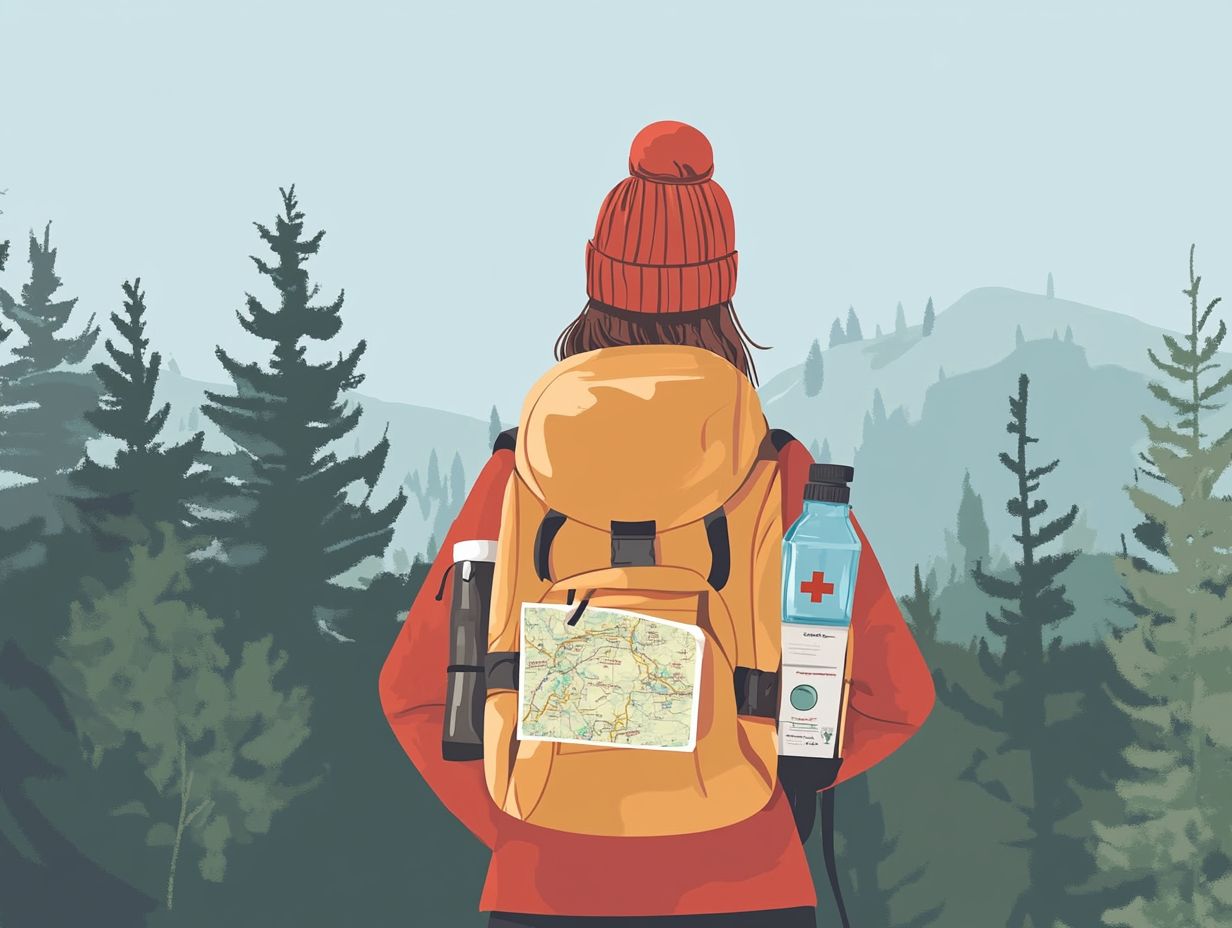
Proper nutrition and hydration for a long hike are crucial elements that significantly influence your energy levels, endurance, and overall performance. Concentrate on balanced meals and effective hydration strategies to ensure you meet all your hiking needs.
Proper Fueling and Hydration Strategies
Proper fueling and hydration strategies are essential for maintaining energy levels during a long hike.
They help you stay energized and ready for any trail condition. To achieve this, meticulously plan your meals with a balanced mix of carbohydrates, proteins, and healthy fats.
This balance makes it easier to sustain your energy throughout the journey. Preparing nutritious snacks like trail mixes or energy bars will give you quick boosts when you need them most.
Establishing a hydration schedule is equally vital. Sipping water regularly before and during your hike keeps your body fueled and reduces the risk of dehydration.
Incorporating sports drinks that replace lost salts and minerals can also enhance your overall performance during longer treks.
By adhering to these strategies, you can maximize your hiking experience, ensuring your body is well-equipped for the challenges ahead.
Emergency Preparedness on a Long Hike
Being prepared for emergencies during your hike is vital for your safety!
Craft a thoughtful plan to tackle potential hiking injuries while ensuring you’re equipped with essential supplies, like a well-stocked first aid kit.
This preparation will help you manage unforeseen circumstances with confidence and efficiency.
Creating a Plan for Emergencies
Creating an emergency plan can truly elevate your hiking experience, enabling you to respond effectively to potential injuries and other incidents.
A well-structured emergency plan involves key components that significantly enhance your outdoor safety.
First, establish clear communication strategies. Designate a point of contact and utilize reliable signaling devices to keep everyone informed during any incident.
Planning your evacuation routes is crucial. Knowing the safest and quickest paths away from hazards can save you precious time.
Carrying a well-stocked first aid kit is also essential. It provides immediate resources to address injuries and medical emergencies as they occur.
Incorporating these elements ensures that you and your fellow hikers are prepared to handle unforeseen circumstances, contributing to a secure and enjoyable adventure in the great outdoors.
Frequently Asked Questions
What are some essential items to bring on a long hike?

Some essential items to bring on a long hike include proper footwear, a backpack with plenty of water and snacks, a map and compass, a first aid kit, and appropriate clothing for the weather.
How physically fit do I need to be to prepare for a long hike?
It is recommended to have a moderate level of physical fitness before embarking on a long hike.
Start with shorter hikes and gradually increase the length and difficulty to build your endurance.
What is the best way to train for a long hike?
The best way to train for a long hike is to incorporate regular cardio and strength training exercises into your fitness routine.
This approach will help improve your overall endurance and strength for the hike.
How should I plan my meals for a long hike?
When planning meals for a long hike, pack lightweight, nutrient-dense foods that are easy to prepare on the trail.
Ensure you have enough food to fuel your body for the entire hike.
What are some safety tips to keep in mind when preparing for a long hike?
Some safety tips include informing someone of your planned route and estimated time of return. Check weather conditions before heading out.
Also, pack a whistle and flashlight for emergencies.
How far in advance should I start preparing for a long hike?
It is recommended to start preparing for a long hike at least 3-6 months in advance, depending on your current level of fitness.
This timeframe allows enough time to gradually build your endurance and make necessary adjustments to your gear and preparations.

